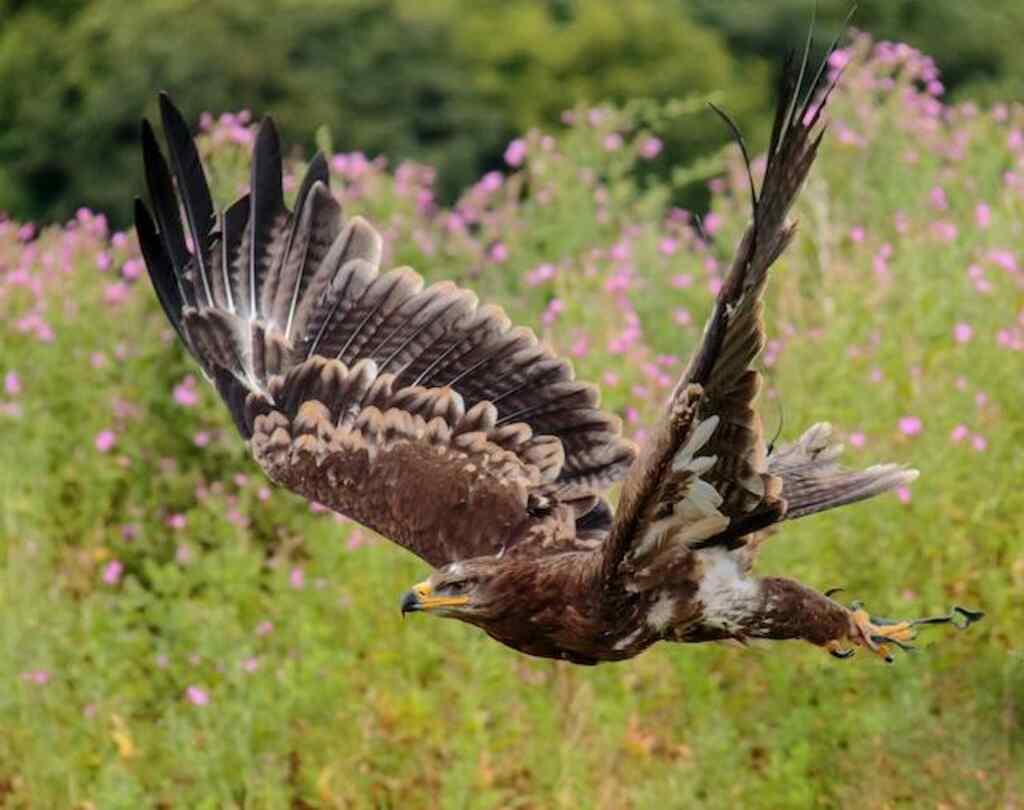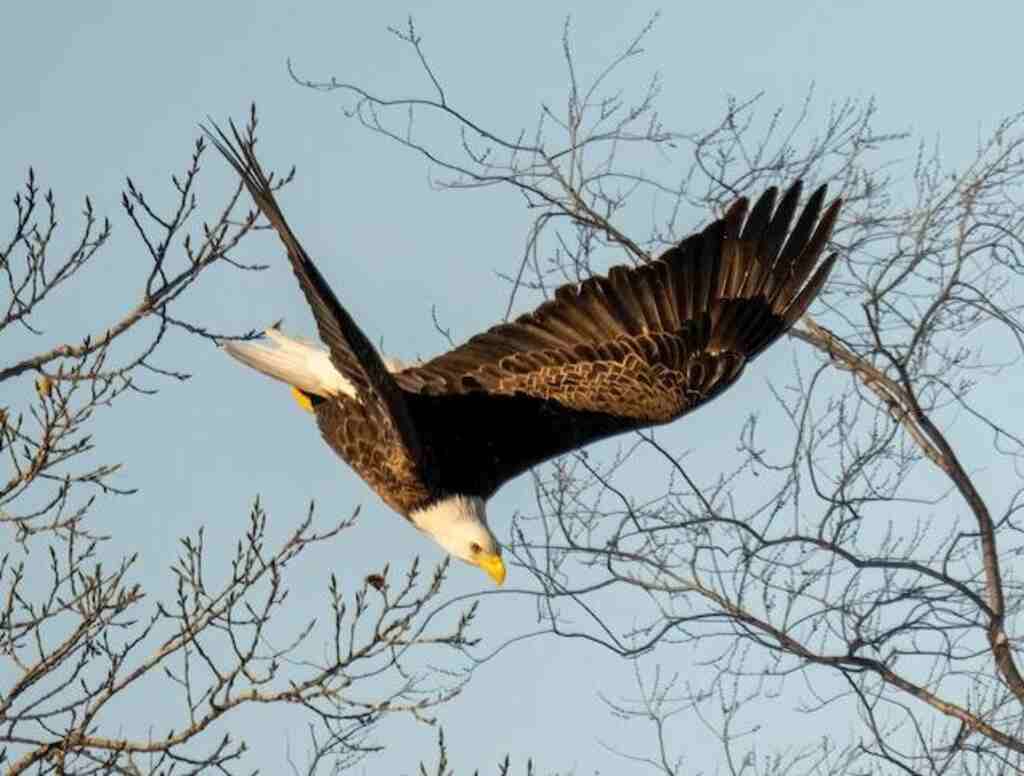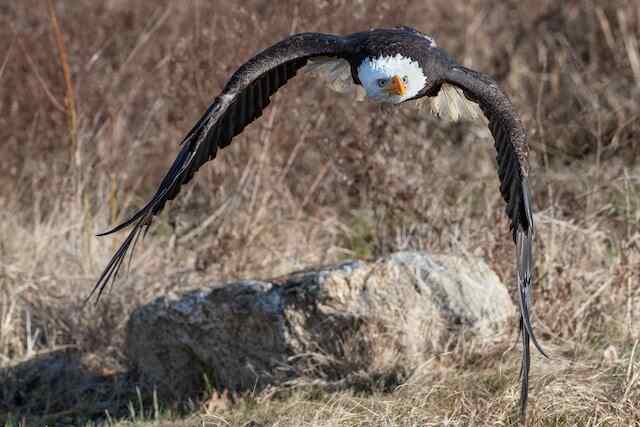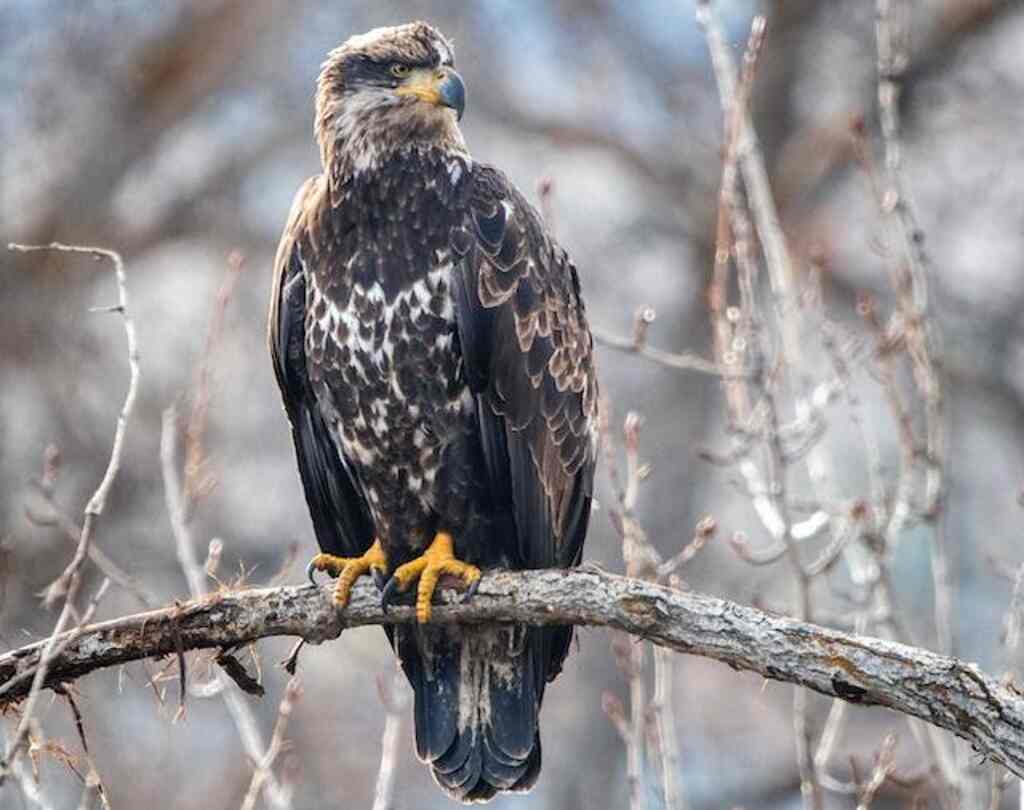Do Eagles Eat Skunks? In the vast and intricate web of the natural world, certain predator-prey relationships have captivated the curiosity of both scientists and nature enthusiasts alike.
Among these, the question whether eagles consume skunks has sparked much intrigue.
Let’s delve into this enigmatic connection, exploring the dietary habits of eagles, the defense mechanisms of skunks, and debunking the myth surrounding their consumption.
Join us as we unravel the fascinating dynamics between these majestic birds of prey and the formidable skunks that roam the land. Get ready for a wild adventure filled with feathers, fur, and a dash of mystery!
Table of Contents
- 1 Key Takeaways
- 2 Do Eagles Eat Skunks
- 3 Introduction to Eagles and Their Dietary Habits
- 4 The Predatory Behavior of Eagles
- 5 An Overview of Skunks and Their Defense Mechanisms
- 6 The Diet of Eagles: What Do They Typically Eat?
- 7 The Myth of Eagles Eating Skunks: Separating Fact from Fiction
- 8 Instances of Eagles Preying on Skunks: Rare but Possible
- 9 Why Eagles Might Not Prefer Skunks as Food
- 10 The Challenges and Risks of Hunting Skunks for Eagles
- 11 Other Predators that Prey on Skunks
- 12 The Important Role of Eagles in the Ecosystem
- 13 Conclusion: Understanding the Complexity of Eagle Diets
- 14 Frequently Asked Questions
- 15 Author
Key Takeaways
- Eagles have a diverse and adaptable diet, including fish, small mammals, birds, reptiles, and carrion.
- Skunks have a strong defense mechanism of spraying a foul-smelling liquid, which eagles try to avoid by targeting the head or neck.
- Instances of eagles preying on skunks are rare but possible, as skunks are also targeted by other predators like great horned owls, coyotes, and bobcats.
- Eagles play an important role in controlling skunk populations and maintaining ecosystem balance by controlling prey populations.

Do Eagles Eat Skunks
While eagles generally do not have skunks as a preferred food source, there have been rare instances where eagles have been observed consuming skunks.
These instances, however, are not a significant part of their diet, and other prey items such as fish, birds, and small mammals are more common.
The consumption of skunks by eagles is infrequent and opportunistic rather than a regular occurrence.
Introduction to Eagles and Their Dietary Habits
Eagles, majestic birds known for their impressive wingspan and keen eyesight, have a diverse and adaptable diet that includes a wide range of prey animals.
Eagles’ feeding habits are characterized by their ability to capture and consume a variety of creatures.
Their diet diversity enables them to thrive in different environments, from coastal areas where they feed on fish to open grasslands where they hunt small mammals.
They are opportunistic feeders and will take advantage of whatever food sources are available to them.
Their diet may include not only fish and small mammals, but also birds, reptiles, and even carrion. This adaptability allows eagles to survive in a wide range of habitats, making them highly successful predators.
Transitioning to the subsequent section about the predatory behavior of eagles, it is fascinating to explore how these birds exhibit their hunting prowess.
The Predatory Behavior of Eagles
Eagles are known for their excellent hunting techniques, which allow them to capture and consume skunks despite their strong defense mechanisms.
Eagles often employ a combination of aerial attacks and ground-based hunting to catch skunks. They have sharp talons and beaks that enable them to grasp and kill their prey effectively.
When hunting skunks, eagles must be cautious as skunks possess defensive adaptations such as their ability to spray a foul-smelling liquid.
To avoid being sprayed, eagles target the head or neck of the skunk, quickly delivering a fatal blow. This allows them to minimize the risk of being sprayed.
Understanding how eagles interact with skunks provides valuable insights into the dynamics of predator-prey relationships.
In the subsequent section, we will provide an overview of skunks and their defense mechanisms.
An Overview of Skunks and Their Defense Mechanisms
Skunks, fascinating creatures in the animal kingdom, possess unique defense mechanisms that enable them to protect themselves from potential predators.
When threatened, skunks have the ability to emit a strong-smelling spray from their anal glands, which can reach a distance of up to 10 feet.
This spray contains sulfur compounds, such as thiols, which have a pungent odor that can cause eye irritation and temporary blindness.
Additionally, skunks are known to exhibit warning behaviors before resorting to spraying, such as stomping their feet, hissing, and arching their backs.
These behaviors serve as a clear indication to predators that the skunk is ready to defend itself. Skunks also have sharp claws and teeth that they can use for physical defense if necessary.
With such effective defense mechanisms, skunks are able to deter many potential predators and ensure their survival.
Transitioning into the subsequent section, it is important to understand the diet of eagles and whether skunks fall within their typical prey.

The Diet of Eagles: What Do They Typically Eat?
Carnivorous birds of prey, such as eagles, have a diverse range of dietary preferences and are known to consume a wide variety of small mammals, fish, reptiles, and birds.
Their feeding habits vary depending on their species, habitat, and availability of prey.
Eagles are opportunistic hunters and have been observed hunting and feeding on rabbits, squirrels, rodents, and even larger animals like prairie dogs or young deer.
Their sharp, curved beaks and strong talons allow them to efficiently catch and kill their prey.
Eagles are also skilled fishers and often snatch fish from the water surface using their sharp talons. While eagles have a broad diet, the myth of eagles eating skunks is largely fiction.
Skunks produce a strong-smelling spray as a defense mechanism, which deters most predators, including eagles.
The Myth of Eagles Eating Skunks: Separating Fact from Fiction
Contrary to popular belief, the notion of eagles devouring skunks is a mere fabrication, as skunks possess a pungent defense mechanism that dissuades most predators.
This myth has been perpetuated by misconceptions and exaggerations. Skunks are equipped with scent glands that emit a foul-smelling spray, compelling even the most formidable predators to retreat.
The spray contains sulfur compounds, such as thiols, which have a strong, repugnant odor.
This defense mechanism is highly effective against most predators, including eagles.
Skunks display warning signs before spraying, such as raising their tail and stamping their feet, providing ample opportunity for predators to back off.
Therefore, instances of eagles preying on skunks are rare but possible, especially in situations where the skunk’s defense mechanism fails or when the eagle is particularly desperate for food.
Instances of Eagles Preying on Skunks: Rare but Possible
In the realm of eagle and skunk interactions, instances of eagles preying on skunks are indeed rare but possible.
While it is a widely perpetuated myth that eagles frequently consume skunks, the reality is quite different.
Eagles are opportunistic predators, known for their diverse diet that primarily consists of fish, small mammals, and birds.
However, there have been documented cases where eagles have targeted skunks as a food source.
These interactions occur infrequently due to the skunk’s formidable defense mechanisms, such as their ability to spray a pungent odor and their sharp claws.
Despite these encounters, it is important to note that eagles may not necessarily prefer skunks as a primary food source.
This raises the question of why eagles might not favor skunks as a regular part of their diet.

Why Eagles Might Not Prefer Skunks as Food
One possible reason for the limited preference of eagles towards skunks as a food source could be the skunk’s potent defense mechanisms.
Skunks possess a unique ability to emit a foul-smelling spray from their anal glands when they feel threatened, which acts as a powerful deterrent against predators.
This spray contains a combination of sulfur compounds that can cause intense irritation and temporary blindness in animals.
Eagles, with their keen sense of smell and sharp vision, are likely to be highly sensitive to the noxious odor and debilitating effects of the skunk’s defensive spray.
Additionally, the skunk’s black and white coloration may serve as a warning signal to potential predators, indicating the presence of these potent defense mechanisms.
Considering these factors, it is understandable why eagles might not prefer skunks as a food source.
Transitioning to the subsequent section about ‘the challenges and risks of hunting skunks for eagles’, it becomes evident that capturing skunks poses unique difficulties for these birds of prey.
The Challenges and Risks of Hunting Skunks for Eagles
Hunting skunks presents unique challenges and risks for eagles, as indicated by the fact that the skunk’s spray can reach distances of up to 10 feet and contains sulfur compounds known to cause temporary blindness in potential predators.
This chemical defense mechanism is a significant challenge faced by eagles when hunting skunks.
Additionally, skunks are not easy prey due to their ability to emit a strong odor that can deter predators.
The strong smell can alert other nearby animals, potentially attracting unwanted attention or competition for the kill.
Moreover, skunks have sharp claws and teeth, posing a risk of injury to the eagle during the hunting process.
Despite these challenges and risks, eagles have been observed hunting skunks, showcasing their adaptability and resourcefulness in acquiring food.
Transitioning to the subsequent section, eagles are not the only predators that prey on skunks.
Other Predators that Prey on Skunks
Skunks, despite their potent defenses, are targeted by a variety of predators in the animal kingdom. These predators have developed strategies to overcome the skunk’s defense mechanisms.
One such predator is the great horned owl, which uses its silent flight and powerful talons to catch skunks unaware.
Other predators, such as coyotes and bobcats, have learned to approach skunks from behind, avoiding the spray of their odoriferous glands.
Skunks have evolved to rely on their strong scent as a primary defense mechanism, but their predators have adapted to this challenge.
They have developed keen senses of smell to locate skunks and have learned to tolerate or even neutralize the foul smell.
These predators play an important role in controlling skunk populations and maintaining the balance of the ecosystem.
Understanding the dynamics between predators and skunks is crucial to comprehending the important role that eagles play in the ecosystem.

The Important Role of Eagles in the Ecosystem
Eagles, with their soaring flight and sharp vision, play a crucial role in maintaining the delicate balance of the ecosystem.
They are apex predators that have a significant ecological impact through their predation on various prey species, including skunks.
The balance of predator-prey relationships in the ecosystem is essential for the overall health and stability of the environment.
To understand the ecological impact of eagle predation, it is important to consider three key sub-lists.
First, eagles help control the population of skunks, which can become overabundant and cause damage to crops and gardens.
Second, by preying on skunks, eagles help regulate the distribution of nutrients within the ecosystem.
Lastly, the presence of eagles and their predation on skunks can influence the behavior and movements of other species, leading to cascading effects throughout the food web.
By studying the complex interactions between eagles and skunks, we can gain a better understanding of the intricate dynamics that shape ecosystems.
This knowledge is crucial for effective conservation and management strategies aimed at preserving the delicate balance of predator-prey relationships.
Conclusion: Understanding the Complexity of Eagle Diets
The intricate web of predator-prey relationships within ecosystems is exemplified by the complexity of eagle diets.
Eagles are opportunistic predators and their diet can vary depending on several factors such as habitat, season, and availability of prey.
While eagles are known to primarily feed on fish, they are also known to prey on a wide range of animals including birds, mammals, reptiles, and even carrion.
| Prey Type | Examples | Importance to Eagle Diet |
|---|---|---|
| Fish | Salmon, Trout | High |
| Birds | Ducks, Gulls | Moderate |
| Mammals | Rabbits, Squirrels | Moderate |
| Reptiles | Snakes, Turtles | Low |
| Carrion | Deer, Sheep carcasses | Low |
By examining this table, it becomes clear that eagles have a diverse diet and play a crucial role in maintaining the balance of ecosystems by controlling populations of various prey species.
Understanding the complexity of eagle diets is important for conservation efforts and ensuring the long-term survival of these magnificent birds.

Frequently Asked Questions
Do skunks pose a threat to eagles?
Skunks can have a significant impact on the ecosystem as prey for other predators. They are an essential food source for many species, contributing to the overall balance and diversity of the ecosystem.
How often do eagles encounter skunks in the wild?
Eagles encounter skunks in the wild with varying frequency, as skunks are prey for several animals. The behavior of eagles towards skunks is influenced by factors such as availability of other prey and the eagles’ hunting strategies.
Are there any benefits to eagles consuming skunks?
The consumption of skunks by eagles can have environmental benefits due to the skunk’s scavenging behavior. Skunks feed on carrion and help clean up the environment, while also providing nutritional value to eagles.
Can eagles successfully hunt skunks?
Eagles possess remarkable hunting techniques that allow them to successfully capture skunks. Skunks, on the other hand, have defensive mechanisms such as spraying a pungent odor, which may deter predators like eagles.
Are skunks a common food source for eagles?
Skunks are not a common food source for eagles. While eagles have impressive skunk hunting techniques, skunks are more commonly preyed upon by other animals. Eagles tend to prefer other small mammals and birds as their primary food sources.



